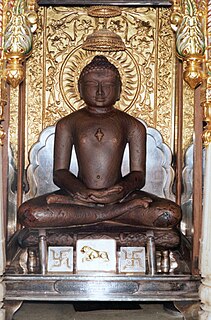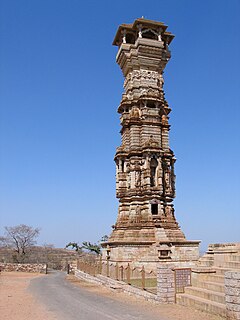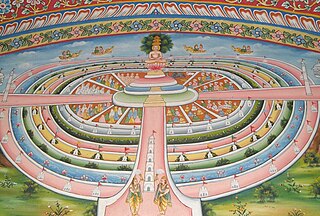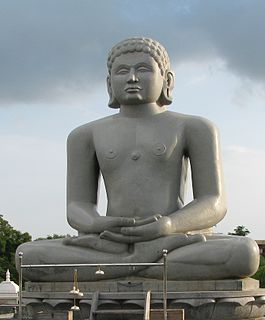
Mahavira, also known as Vardhamana was the 24th tirthankara of Jainism. He was the spiritual successor of 23rd tirthankara Parshvanatha. Jain tradition holds that Mahavira was born in the early part of the 6th century BCE into a royal Kshatriya Jain family in present-day Bihar, India. He abandoned all worldly possessions at the age of about 30 and left home in pursuit of spiritual awakening, becoming an ascetic. Mahavira practiced intense meditation and severe austerities for 12 years, after which he is believed to have attained Kevala Jnana (omniscience). He preached for 30 years and is believed by Jains to have attained moksha (salvation) in the 6th century BC, although the year varies by sect.

The Dilwara Temples or Delvada Temples are located about 2 1⁄2 kilometres from the Mount Abu settlement, Rajasthan's only hill station. These Jain temples were built by Vimal Shah and designed by Vastupala, Jain minister of Dholka, between the 11th and 16th centuries and are famous for their use of white marble and intricate marble carvings. They are a pilgrimage place of the Jains, and a popular general tourist attraction. Although Jains built many beautiful temples at other places in Rajasthan, the Dilwara temples are believed to be the most beautiful example of architectural perfection. The temples have an opulent entranceway, the simplicity in architecture reflecting Jain values like honesty and frugality. The ornamental detail spreading over the minutely carved ceilings, doorways, pillars, and panels is simply marvellous. It is said that workmen were paid in gold according to the weight of marble powder scraped off.

Parshvanatha, also known as Parshva and Paras, was the 23rd of 24 tirthankaras of Jainism. He is one of the earliest tirthankaras who are acknowledged as historical figures. He was the earliest exponent of Karma philosophy in recorded history. The Jain sources place him between the 9th and 8th centuries BC whereas historians point out that he lived in the 8th or 7th century BC. Parshvanatha was born 332 years before Mahavira. He was the spiritual successor of 22nd tirthankara Neminath. He is popularly seen as a propagator and reviver of Jainism. Parshvanatha attained moksha on Mount Sammeta in the Ganges basin, an important Jain pilgrimage site. His iconography is notable for the serpent hood over his head, and his worship often includes Dharanendra and Padmavati.

Rajasthan, a state in western India, has had a close historical connection with Jainism. Southwestern Rajasthan was the main centre for Svetambara Jainism. Major Digambara centres are in the northern and eastern parts of Rajasthan.

Stambha is used to denote pillar or column. In the context of Jain and Hindu mythology, it is believed to be a cosmic column which functions as a bond, which joins the heaven (Svarga) and the earth (Prithvi). A number of Hindu scriptures, including the Atharva Veda, have references to Stambha. In the Atharva Veda, a celestial stambha has been described as an infinite scaffold, which supports the cosmos and material creation.

In Jainism, Samavasarana or Samosharana is the divine preaching hall of the Tirthankara. The word samavasarana is derived from two words, sama, meaning general and avasara, meaning opportunity. It is a place where all have an opportunity to acquire wisdom. The divine pavilion is built by heavenly beings (devas) after the tirthankara attain omniscience. The theme of Samavasaranas has been popular in Jain art. The Samavasarana seems to have replaced the original Jain stupa as an object of worship.

Panchakuta Basadi is a temple complex located in the Kambadahalli village of the Mandya district, Karnataka state, in southwestern India. It is one of the finest examples of South Indian Dravidian architecture of the Western Ganga variety, related to the Jain faith and iconography.

A Jain temple or Derasar is the place of worship for Jains, the followers of Jainism. Jain architecture is essentially restricted to temples and monasteries, and secular Jain buildings generally reflect the prevailing style of the place and time they were built.

Māllīnātha was the 19th tīrthaṅkara "ford-maker" of the present avasarpiṇī age in Jainism. Jain texts indicate Mālliṇātha was born at Mithila into the Ikshvaku dynasty to King Kumbha and Queen Prajâvatî. Tīrthaṅkara Māllīnātha lived for over 56,000 years, out of which 54,800 years less six days, was with omniscience.

Neminatha is the twenty-second Tirthankara (ford-maker) in Jainism. He is also known simply as Nemi, or as Aristanemi which is an epithet of the sun-chariot. Along with Mahavira, Parshvanatha and Rishabhanatha, Neminatha is one of the twenty four Tirthankaras who attract the most devotional worship among the Jains.
Kirti Stambha is a 12th-century tower situated at Chittor Fort in Chittorgarh town of Rajasthan, India. The 22-metre-high tower was built by a Jain merchant Jeeja Bhagerwala during the reign of Rawal Kumar Singh for the glory of Jainism.

Digambara is one of the two major schools of Jainism, the other being Śvētāmbara (white-clad). The word Digambara (Sanskrit) means "sky-clad", refers to their traditional monastic practice of neither possessing nor wearing any clothes.

Jain sculptures or Jain idols are the images depicting Tirthankaras. These images are worshiped by the followers of Jainism. The sculpture can depict any of the twenty-four tirthankaras with images depicting Parshvanatha, Rishabhanatha, or Mahāvīra being more popular. Jain sculptures are an example of Jain art. There is a long history of construction of Jain sculptures. Early examples include Lohanipur Torsos which has been regarded to be from the Maurya period, and images from the Kushan period from Mathura.

Ranakpur Jain temple or Chaturmukha Dharana Vihara is a Jain temple at Ranakpur is dedicated to Tirthankara Rishabhanatha. The temple is located in a village of Ranakpur near Sadri town in the Pali district of Rajasthan.

The Ajmer Jain temple, also known as Soniji Ki Nasiyan, is an architecturally rich Jain temple. It was built in the late nineteenth century. The main chamber, known as the Swarna Nagari "City of Gold", has several gold-plated wooden figures, depicting several figures in the Jain religion. This golden chamber of the temple uses 1000 kg of gold to carve out a depiction of Ayodhya.

The Tyagada Brahmadeva Pillar is a decorated free standing pillar, 2.3 m tall, commissioned by Chamundaraya, an important minister and commander in the Western Ganga kingdom, during the rule of King Marasimha II (963–975), Rachamalla IV (975–986) and Rachamalla V. The pillar dates to around 983 C.E. and exists on the Vindyagiri hill in the important Jain heritage town Shravanabelagola, in the Karnataka state, India. On the base of the pillar, on the north side, is an inscription in old Kannada language of the same period, which according to epigraphist and historian B.L. Rice confirms Chamundaraya's involvement in the erection of the pillar. Free standing pillars are a characteristic feature of the Western Ganga art and are broadly classified as "Mahastambha" and "Brahmastambha".

Jainism is an Indian religion which is traditionally believed to be propagated by twenty-four spiritual teachers known as tirthankara. Broadly, Jainism is divided into two major schools of thought, Digambara and Svetambara. These are further divided into different sub-sects and traditions. While there are differences in practices, the core philosophy and main principles of each sect is same.

Jain art refers to religious works of art associated with Jainism. Even though Jainism spread only in some parts of India, it has made a significant contribution to Indian art and architecture.

In Jainism, Chandraprabha was the eighth Tirthankara of Avasarpini. Chandraprabhu was born to King Mahasena and Queen Lakshmana Devi at Chandrapuri to the Ikshvaku dynasty. According to Jain texts, his birth-date was the twelfth day of the Posh Krishna month of the Indian calendar. He is said to have become a siddha, i.e. soul at its purest form or a liberated soul.

Bharata was the first chakravartin of avasarpini. He was the eldest son of Rishabhanatha, the first Tirthankara of Jainism. According to the Jains the ancient name of India was named "Bhāratavarsha" or "Bhārata" or "Bharata-bhumi" after him. He had two sons from his chief Queen Sunanda - Arkakirti and Marichi. He conquered all the six parts of the world and fought with Bahubali in the end to conquer the last remaining city.



























